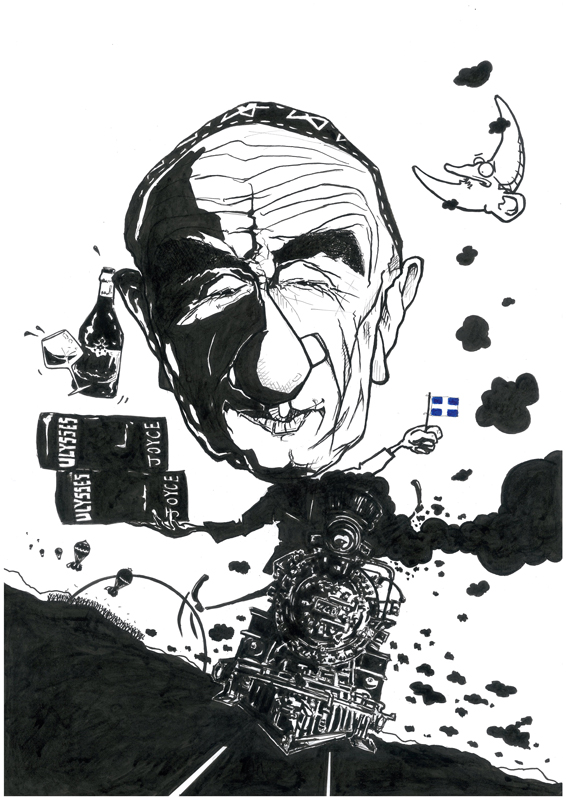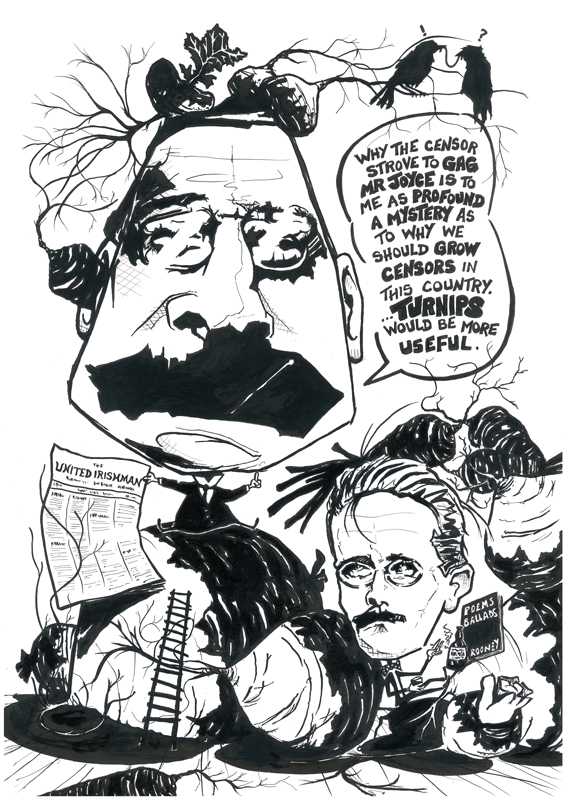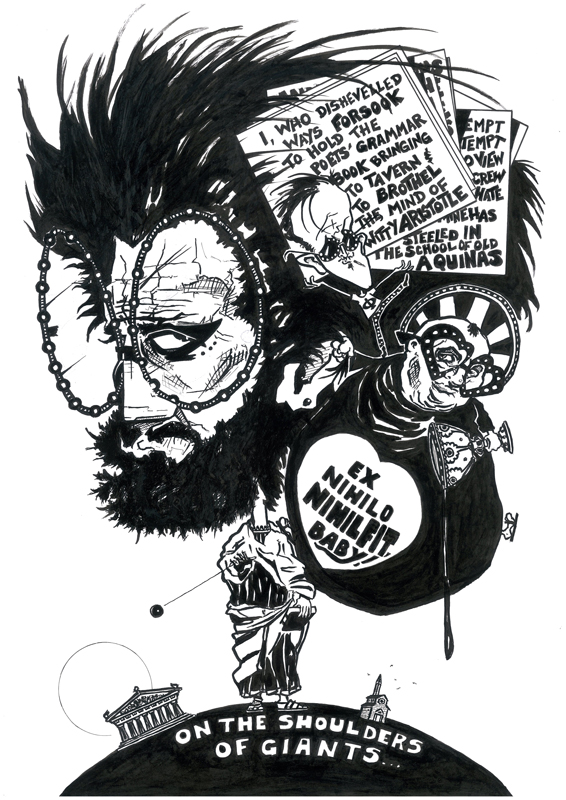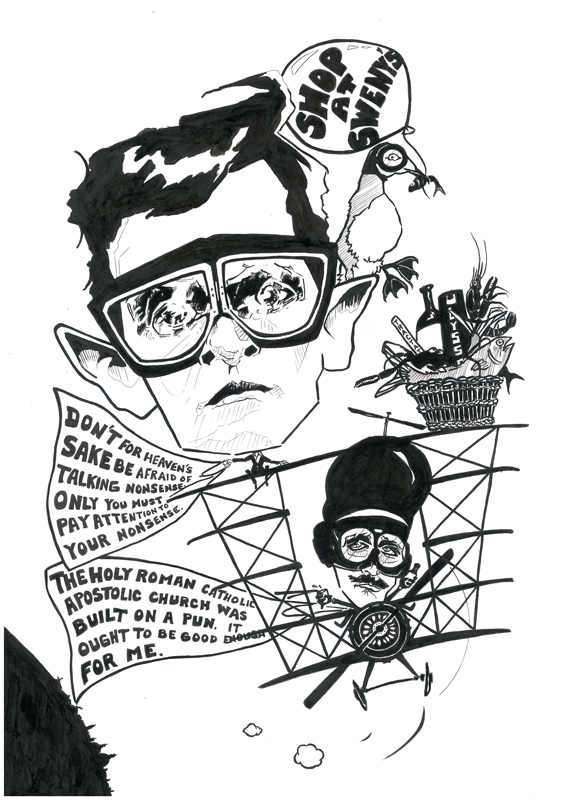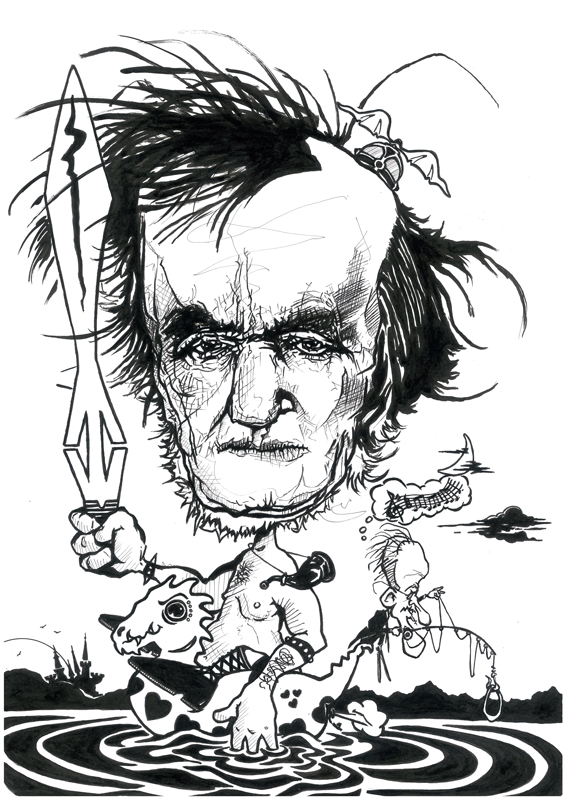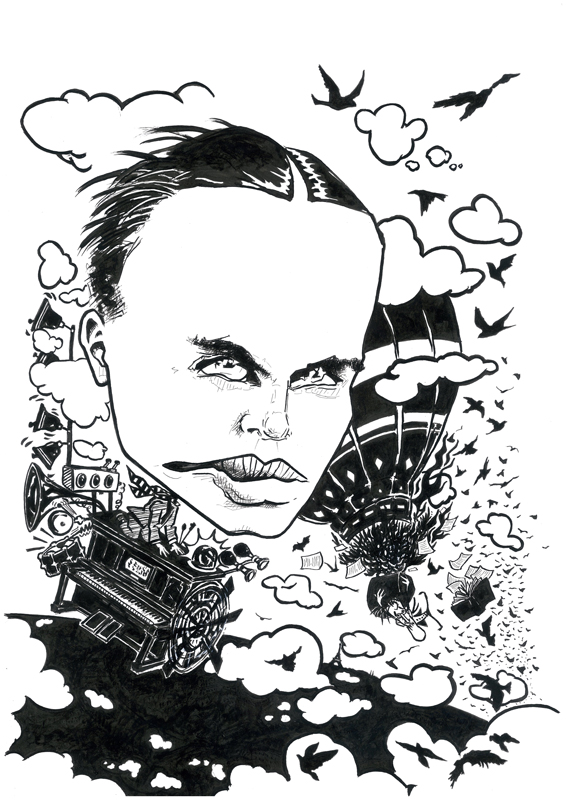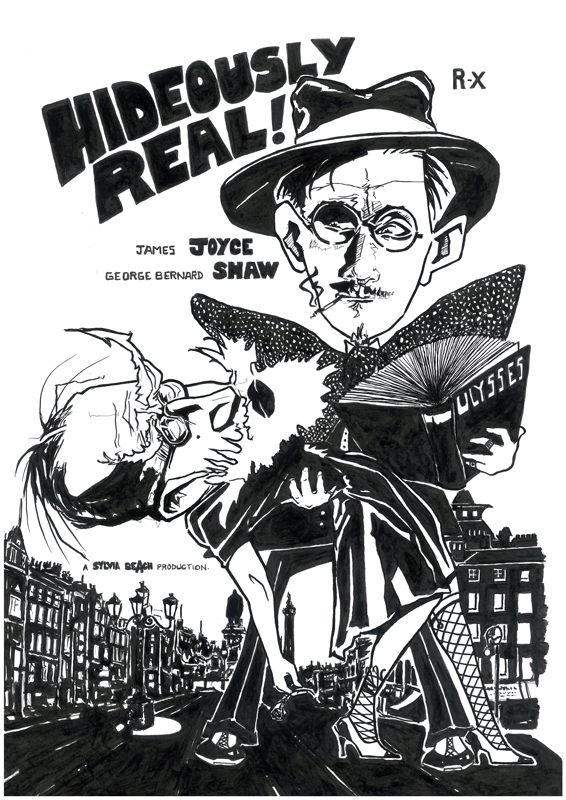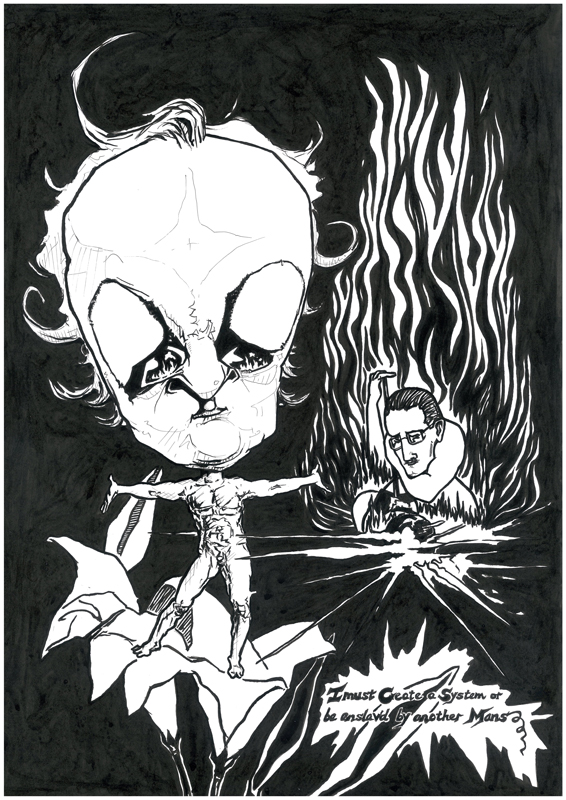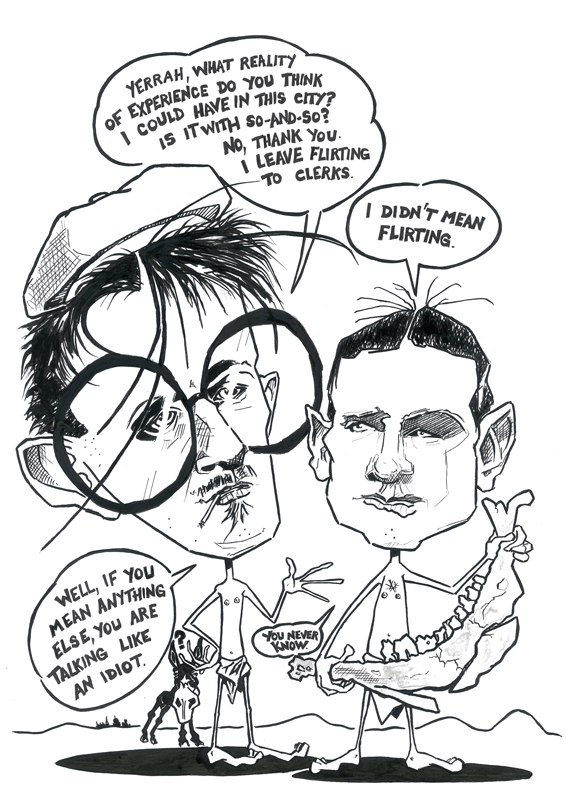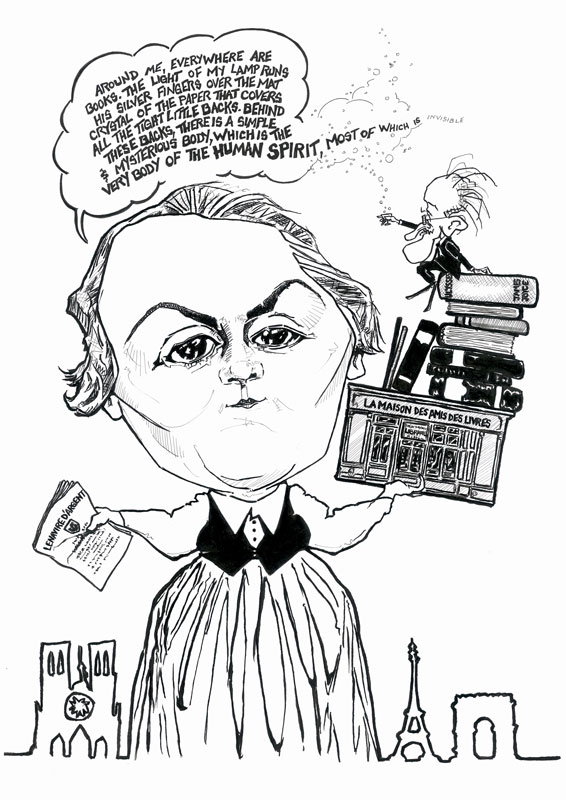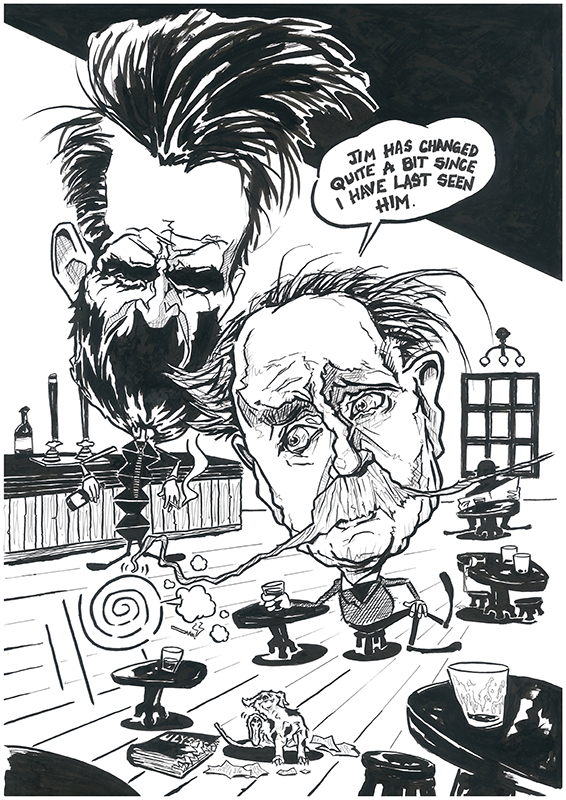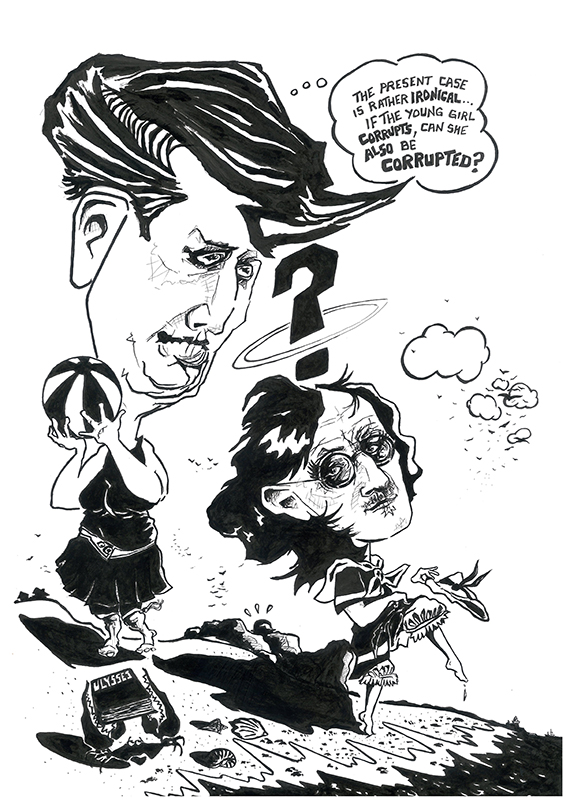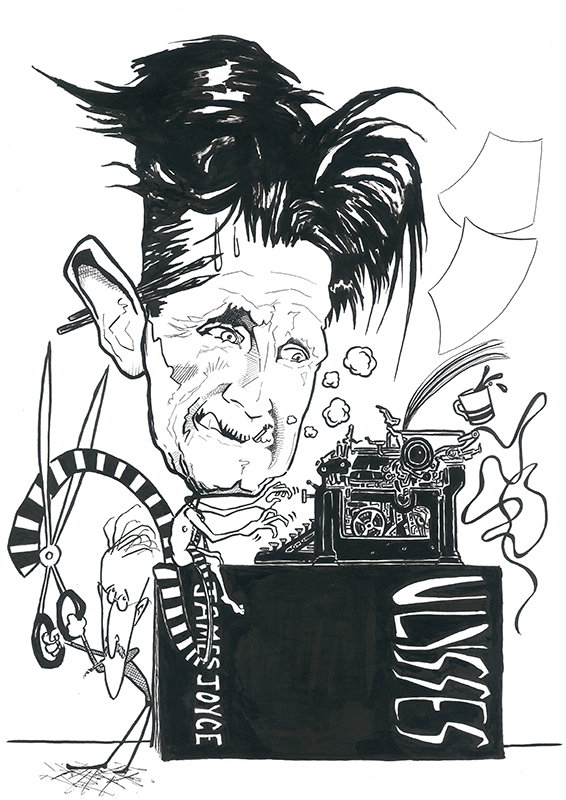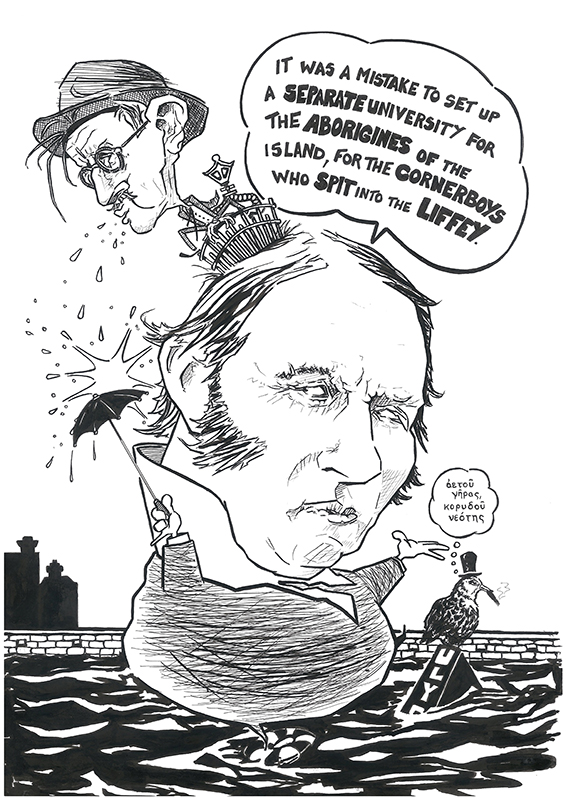Works in Indian ink, Indian ink wash, gouache, marker & pencil
MAURICE DARANTIERE
Darantiere was a Dijon printer who printed the very first edition of Ulysses. He and his small team spoke very little English so that edition is famously full of mistakes. Darantiere met his deadline and had the book sent to Paris on the Dijon-Paris morning express on the 2nd February (1922) – Joyce’s birthday. Darantiere carries the Greek flag (as it was then) because Joyce insisted the first edition be issued in ‘Greek blue’ … which Darantiere went to great lengths to honour.
ARTHUR GRIFFITH
Eventually the founder of the Sinn Fein political party but here – early 1900s – Arthur Griffith is portrayed as the founder and editor of The United Irishman nationalist newspaper, defiantly proud publisher of Joyce’s articles against censorship, refused elsewhere. The text is a direct quote. Joyce reviewed the minor and sentimental poet William Rooney’s posthumously published work, Poems and Ballads, and fairly savaged it, even though Rooney had been a good friend of Griffith.
ARISTOTLE AND AQUINAS
Aristotle is modelled after Raphael’s Vatican version in his painting The School of Athens, and both he and Thomas Aquinas are portrayed as rock/pop stars, given that they were Joyce’s adolescent heroes. Here, Aristotle is a bit Jim Morrison, while Aquinas is a medieval Elton John. Aquinas’ little church is taken from the Carlo Crivelli portrait and Joyce’s text is from his scurrilous teenage poem ‘The Holy Office’- presented in flash card form in homage to Bob Dylan’s famous Subterranean Homesick Blues video.
LUDWIG WITTGENSTEIN
Joyce and Wittgenstein never met but they shared similar thoughts and ideas on language and speech. As Megan Quigley writes in her recent book, Fiction And Vagueness (CUP 2018): ‘Joyce’s Ulysses can be seen to carry out his “curse” by subverting the systems – social, religious, philosophical – that entrap Ireland. Joyce’s vagueness underscores what Wittgenstein calls the “arbitrary” rules of language, emphasising the contingency of Ireland’s fixed social systems. By changing the rules of the novel game in Ulysses and flouting the rules of recognisable language in Finnegans Wake, Joyce’s works force readers to be willing players. Moreover, if social systems, as well as the language that describes them, are based on malleable rules, there seems no reason why readers, or the citizens of his homeland, cannot choose to revise the rules. Joyce’s vagueness therefore joins in Wittgenstein’s philosophical revolt, hoping to change an outdated system. “At present we are combatting a trend,” Wittgenstein argues, “But this trend will die out, superseded by others.” Similarly, although Ulysses ends with Bloom pondering the “irreparability of the past,” his optimism for the future, like Molly’s final “yes,” will not be destroyed, “because at the critical turning point of human existence he desired to amend many social conditions.”’ (And as for the Irish guillemot, advertising Sweny’s on a big balloon, it’s there just for fun.)
RICHARD WAGNER – 2
In this version Wagner sits astride an inflatable dragon pool toy and Joyce fishes for the Ring whilst humming Siegfried’s horn melody.
GEORGE ANTHEIL
The American modernist composer George Antheil employed player pianos, fans, electric bells and propellers in his work, and tried but sadly failed to set some of Joyce’s Ulysses to music.
GEORGE BERNARD SHAW
Shaw and Joyce pose dramatically in a mock film noir poster, inspired by Shaw’s thoughts on the prospect of purchasing Ulysses. In a letter to Sylvia Beach, Shaw wrote: “Dear Madam, I have read several fragments of Ulysses in serial form. It is a revolting record of a disgusting phase of civilisation; but it is a truthful one; and I should like to put a cordon round Dublin; round up every male person in it between the ages of 15 and 30; force them to read it; and ask them whether on reflection they could see anything amusing in all that foul mouthed, foul minded derision and obscenity. To you, possibly, it may appeal as art; you are probably … a young barbarian beglamoured by the excitements and enthusiasms that art stirs up in passionate material; but to me it is all hideously real: I have walked those streets and known those shops and have heard and taken part in those conversations. … I must add, as the prospectus implies an invitation to purchase, that I am an elderly Irish gentleman, and that if you imagine that any Irishman, much less and elderly one, would pay 150 francs for a book, you little know my countrymen.”
IGOR STRAVINSKY
Joyce was not – by some accounts – a huge fan of Stravinsky’s because – so the story goes – he couldn’t sing to his music (Joyce had an excellent tenor voice). However it’s my guess that Joyce was simply jealous of the Russian’s genius, notoriety and success. Stravinsky was also present at the infamous dinner at The Majestic (see PROUST – 2020 Exhibition) and, like Joyce, had an awkward encounter with the great French writer. The notation emerging from Stravinsky’s left ear is from Le Sacre.
WILLIAM BLAKE
Joyce assumes the pose of Blake’s Los. His face is modelled after British artist Lawrence Mynott’s portrait which graces the cover of Penguin Modern Classics Ulysses – The Corrected Text. Blake himself poses as his own joyful Albion Rose or Glad Day – Blake’s symbol of dawning political consciousness and liberty. Writes Ellmann in his Joyce biography: ‘Joyce acquits Blake peremptorily of the charges of insanity and vague mysticism. For the first, “To say that a great genius is mad, while at the same time recognising his artistic merit, is no better than to say he is rheumatic or diabetic.” For the second, he was a mystic only insofar as he could be one and remain an artist; his mysticism was no swooning ecstasy like that of St. John of the Cross, but a Western mysticism filled with an “innate sense of form and the coordinating power of the intellect.”’
OSCAR WILDE
Wilde and Joyce make up a tragic pietà. Joyce considered Wilde something of a crucified Christ figure, despite the latter’s love of posing as a Lucifer type. The green carnation was, for a time, Wilde’s (symbolic) flower, far more so than the white lily. Wilde was a great aesthete and advocate of Art For Art’s Sake, insisting Art must not imitate Nature but Nature Art. As there is no such thing as a green carnation in nature, many of Wilde’s acolytes dyed them that colour, and for a time they were available to purchase at a Chelsea and Fulham flower stall.
STANISLAUS JOYCE
Joyce’s long-suffering younger brother, Stanislaus was a huge support to Joyce and his family – intellectual and spiritual as well as financial. Both James and Nora could be harshly indifferent to him, despite his efforts. Compared to his brother, Stanislaus was relatively strait-laced and conservative. His posthumously published memoir of his life with his famous brother is titled My Brother’s Keeper, referencing the biblical Cain, of course, and here Stanislaus stands with the legendary fratricidal weapon of choice, the jaw bone of an ass. Joyce’s words are taken from those memoirs.
ADRIENNE MONNIER
Sylvia Beach’s friend, mentor and lover, Adrienne Monnier was running her own little bookshop and library, La Maison des Amis des Livres, in Paris, when she first met Beach, a somewhat nervous but highly inquisitive customer. The history of the publication of Ulysses would look very different today were it not for this wonderful woman. Here she holds a copy of the French language review she launched in 1925, Le Navire d’Argent. (The writer and later Resistance fighter, Jean Prévost, was its literary editor.) The words are Monnier’s own.
JOHN STANISLAUS JOYCE & CONSTANTIN BRANCUSI
In Ulysses, Stephen Dedalus says ‘A father is a necessary evil.’ So much of Stephen’s father’s character is inspired by that of Joyce’s own father, John Stanislaus. In her great soliloquy at the end of Ulysses, Molly Bloom refers to living in Ontario Terrace, Dublin, where John Stanislaus and his wife had first lived (eventually going on to make many many moves throughout their – and their children’s – lives, largely due to John’s financial ineptitude and heavy drinking). Joyce inherited his excellent singing voice from his father, and Molly recalls singing a duet with Stephen’s father: ‘… Simon Dedalus too he was always turning up half-screwed singing second verse first the old love is the new was one of his so sweetly sang the maiden on the hawthorn bough he was always on for flirtyfying too when I sang Maritana with him at Freddy Mayers’ private opera he had a delicious glorious voice Pheobe dearest goodbye sweetheart he always sang it not like Bartell dArcy sweet tart goodbye of course he had the gift of the voice so there was no art in it all over you like a warm showerbath O Maritana wildwood flower we sang splendidly though it was a bit too high for my register even transposed and he was married at the time to May Goulding but then hed say or do something to knock the good out of it hes a widower now I wonder what sort is his son he says hes an author and going to be a university professor of Italian …’ The above caricature of John Stanislaus is clearly modelled after Patrick Tuohy’s portrait of him, which James commissioned and hung in his Paris apartment. As for the above portrait of James himself, sat at the table opposite his father’s, it is that by the Romanian sculptor Brancusi (his body bearing the form of one of his sculptures), who observes them both from the bar. On first being shown Brancusi’s portrait of his son, John Stanislaus reportedly uttered the words recorded here. (With thanks to Colm Tóibín: ‘His Spittin’ Image’ – London Review of Books, Vol. 40 No. 4 – 22 February 2018.)
ALDOUS HUXLEY
This was Joyce’s reply to the Italian editor Nino Frank after Frank had suggested Joyce translate some of D. H. Lawrence’s work for the Surrealist-leaning, avant-garde Parisian art and literary journal, Bifur. Joyce had little time for Lawrence (the feeling was mutual – see D H LAWRENCE, 2020 Exhibition) and his arch and dismissive reply reflected this. Huxley had little time for Joyce and although he expressed some guarded admiration for Ulysses, it is doubtful that he understood what the book or Joyce were really about (hence his blank thought bubble and his umbrella prodding Joyce like some alien life form). In answer to an interviewer’s question, “Were you much taken with Joyce?”, Huxley replied: “Never very much – no. I never got very much out of Ulysses. I think it’s an extraordinary book, but so much of it consists of rather lengthy demonstrations of how a novel ought not to be written, doesn’t it? He does show nearly every conceivable way it should not be written, and then goes on to show how it might be written.” Joyce’s French translates: “That man [D H Lawrence] really writes very badly. You might ask instead for something from his friend Aldous Huxley, who at least dresses decently.” (As cited in Ellmann, James Joyce, 1983.)
JANE HEAP
Co-editor with Margaret C. Anderson of the modernist arts and literary magazine, The Little Review, Jane Heap was a fierce and fearless defender of the artists and writers she championed. Joyce’s Ulysses was serialised in the magazine from 1918 until 1921, when the U.S. Post Office seized copies and declined to distribute them, citing obscenity. Along with Anderson, Heap and the magazine faced trial and were defended by John Quinn, the well-known and highly regarded lawyer who was also a major supporter of the modernist movement. Quinn lost. Heap and Anderson were fined fifty dollars each. In answer to the typical, daft nonsense bleated by John Sumner, Secretary of State for the Suppression of Vice (see EZRA POUND & JOHN S SUMNER, 2020 Exhibition), Heap wrote: “Joyce was not teaching early Egyptian perversions nor inventing new ones. Girls lean back everywhere, showing lace and silk stockings … men think thoughts and have emotions about these things everywhere – seldom as delicately and imaginatively as Mr. Bloom – and no one is corrupted.” In the above illustration, inspired by the Nausicaa episode in Ulysses, Heap observes the young and pretty Gerty MacDowell (an unusually coquettish Joyce in drag) on the beach as an aroused Bloom watches her (with his ‘superbly expressive’ eyes?) from behind the rocks. Gerty is pining for the boy – Reggy Wylie – who recently dropped her, as she leans against a rocky outcrop to rest her lame foot. The long Roman candle has yet to launch. Heap’s words here are her own, taken from her above-cited reply to the staggeringly stupid Sumner et al.
VALERY LARBAUD
Esteemed writer and critic, Larbaud met Joyce at the end of 1920 and only months later was making clear to Sylvia Beach his exceptionally high opinion of Ulysses (Joyce had shown him the proofs, pre-publication). Larbaud allowed Joyce and his family to move into his apartment – rent free – at 71 rue du Cardinal Lemoine, Paris. In December 1921, Larbaud gave a now famous lecture on Ulysses, promoting it as a great work of European literature and assertively refuting any accusations of obscenity then being made against it. (On a personal note: my first and lasting impression of Larbaud from his photographs is, erroneously, of a man of very high forehead – first impressions I’ve never been able to shake. In this caricature I’ve indulged this wilful misreading of the man’s head-height in honour of the capacious brain within.)
GEORGE ORWELL
Some months after managing to procure a still illicit copy of Ulysses (the year was 1933), Orwell wrote a long letter to Brenda Salkeld in reply to her question “What do you think Joyce is after?”: “… one has got to decide what a novel normally sets out to do. I should say that it sets out first … to display or create a character, secondly to make a kind of pattern or design which any good story contains, and, thirdly, if the novelist is up to it, to produce good writing which can exist almost as it were in vacuo and independent of subject … I think Ulysses follows this scheme fairly closely, but the queer and original thing about it is that instead of taking as his material the conventional and highly simplified version of life in most novels, Joyce attempts to present life more or less as it is lived.” Roughly a year on, Orwell wrote to Salkeld to say: “I managed to get my copy of Ulysses through safely this time. I rather wish I had never read it. It gives me an inferiority complex. When I read a book like that and then come back to my own work, I feel like a eunuch who has taken a course in voice production … but if you listen closely you can hear the good old squeak just the same as ever.” In this drawing, Orwell the potential eunuch sweats away at the book he was writing at the time – The Clergyman’s Daughter – which bears the weighty influence of Joyce to such an extent it might have fatally damaged Orwell as a writer forever, had he not gone on to reclaim his own plain, direct and documentary style already demonstrated to such great effect in Down and Out in Paris and London.
J P MAHAFFY
Famous Irish Hellenist, writer and wit (Oscar Wilde was one of his students at Trinity and the two were friends for a time but Mahaffy did not support Wilde when he fell foul of the law) … and very loyal to the Crown, Mahaffy earned the ire of Irish language-supporters when he tried to have Irish removed from the intermediate curriculum because there was no literature in the language that was not ‘religious, immoral or indecent’ (so Joyce as depicted above is the sort of ‘yobbo’ of whom Mahaffy speaks). In Lady Augusta Gregory’s ‘dedication of the Irish edition of Cuchulain of Muirthemne to the people of Kiltartan’ (writes Declan Kiberd in Ulysses and Us – 2009), ‘she confessed that she had removed material … to protect the native culture from the sneers of the professors at Trinity College. In evidence to the Committee on Intermediate Education in 1889, Trinity don J. P. Mahaffy had said it would be a mistake to encourage the study of Gaelic literature, as Robert Atkinson (Professor of old Irish at Trinity) declared that many Irish-language texts were unfit to be left in the house within reach of his daughters.’ Mahaffy’s above words were uttered after the publication of Ulysses and intended as a direct reference to Joyce and his work. The top-hatted bird here is a turnstone – a not uncommon sight on the banks of the Liffey – spouting an ancient Greek proverb in support of Mahaffy: ‘An eagle’s old age is worth a sparrow’s youth’.
MARIA JOLAS
Kentucky-born, a grandniece of Thomas Jefferson, Maria McDonald worked as a singer in New York, Berlin and Paris where she met journalist and poet Eugene Jolas and then married in New York in 1926. Upon their return to Paris the couple founded the literary and arts magazine transition. Maria Jolas came into Joyce’s life some four years after the publication of Ulysses, but because she outlived both him and most of his contemporaries, her recollections of her time with them all became a valuable – if not definitive – account of one of the key moments in Modernism. In addition to running the Ecole Bilinge for English and American students, she was a gifted translator of works by Hofmannsthal, Sarraute and Bachelard and, with her husband, titles by Kafka, Broch and Döblin. Not long before Joyce’s death, and in the shadow of the Nazi advance on France, she enticed him and his family to leave Paris and join her at a chateau not far from Vichy for their safety. They did not remain long before the Joyces left for Switzerland where James died in Zurich on 13 January 1941. Maria Jolas returned to the United States shortly thereafter. Reunited with her husband, she became a progressive voice speaking out on race relations and against the war in Vietnam. She died in Paris, France in 1987, perhaps the last of many influential women who had selflessly assisted Joyce throughout his life. As he acknowledged to the Swiss art historian Carola Giedion-Welcker: “Throughout my life women have been my most active helpers.” (Ellmann, James Joyce – p 634n.)
W H AUDEN
Concerning Jane Austen, Auden wrote: “Beside her Joyce seems as innocent as grass.” So we have Austen as the tough old thorny/prickly English rose, and Joyce the greatly diminished ‘tall blade’ between them. Auden’s fingers drip blood after his many bold attempts to prune Austen back. He toasts Jane with his infamous Auden martini – one glass of many poured from a very large bottle of gin with very little vermouth, if any at all (his guests often found drinking with him very tough going). In W. H. Auden – A Biography (1981), Humphrey Carpenter briefly addresses Auden’s mixed feelings about Joyce: Auden ‘expressed a qualified admiration for Joyce’s work. In an interview for Isis (8 November 1967, p. 14) he said “Joyce was an undoubted genius. But a madman. . . He asked you to stand in the same relation to his writing as you must to your life. It is as if he said you must spend your whole life reading me and never give me up or escape.”’

